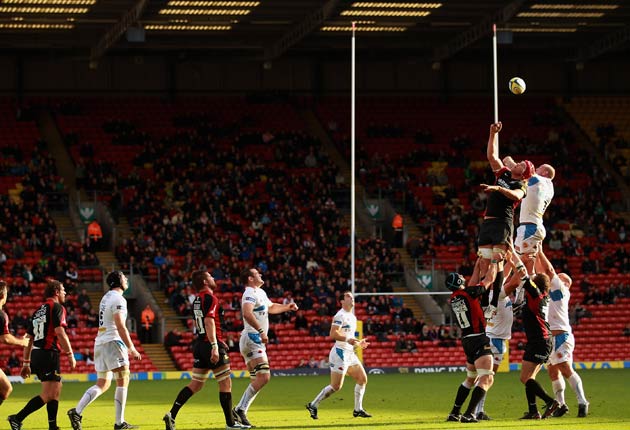International Rugby Board chief executive Mike Miller tonight insisted that Saracens' plans for a plastic pitch are "good for the game".
The Aviva Premiership club have announced they will play on artificial turf next season if proposals to refurbish and relocate to Barnet Copthall Stadium are approved.
Saracens are to begin discussions with the London Borough of Barnet about the viability of developing the ground into a multi-purpose sports venue.
The IRB have been working with football's world governing body FIFA in the development of artificial pitches. Miller believes they will improve the sport as a spectacle and could lead to safer scrummaging.
"We have been working for a number of years with FIFA to come to a standard for artificial surfaces around the world so you can play rugby and football on them," Miller told Press Association Sport.
"Unfortunately here people have the image of QPR in the 1980s. It is a totally different thing now.
"It looks like a grass pitch now and it plays as well as a grass pitch, if not better. I think it is good for the game.
"There is an argument that the southern hemisphere play more attractive, attacking rugby because they can keep their footing and throw the ball around.
"Here (in Europe) you have the heavy pitches and so it makes it a bit harder to do that. Will it change that? Maybe. It will be interesting to see.
"There are no injury issues. We have done studies over the years and there are no differences in the injury rates or types of injuries.
"Scrummaging on them is fine. If you look at some of the grass pitches and the way they cut up, this is better than a lot of situations."
In November 2008, Australia played the Barbarians at Wembley on turf which was not strong enough to handle the force of a top-class scrum contest.
The Australian Rugby Players' Association raised health and safety concerns after Matt Dunning and Sekope Kepu were both injured in the same collapsed scrum.
The introduction of artificial pitches will no doubt find opposition among the traditionalists, for whom playing rugby under a closed roof is also a betrayal of the sport's ethos.
Miller is prepared for opposition to the pitches but it would seem inevitable that a top-tier Test match will be played on one of the surfaces before too long.
"People don't necessarily like change but once they see the change they can't imagine what it was like before," he added.
"How you play is not just determined by the conditions. It is also determined by the talent you have on your team - how big your pack is, how fast your wingers are, different skills and also adapting to what the other team is doing.
"I don't think it will end up with one homogenous game. The good thing about rugby is you can play it many different ways and still win and still have a good spectacle.
"It just gives you a better stage to play it on."
Saracens have worked with the Rugby Football Union over their plans for the pitch and Twickenham chief executive John Steele described it as "an exciting development in English rugby".
Steele added: "There are now more than 20 third generation pitches, either training or full size for match play, across the country.
"They not only provide a smooth and even surface suited to the fast pace of the modern game but are more durable to weather and help reduce game cancellations.
"We will continue to work with Saracens and Premiership Rugby to ensure that the surface is compliant under IRB Regulation 22, the performance specification for artificial surfaces for rugby."
Last February the England Students game against Irish Colleges was switched at very short notice to Gosforth's Druid Park artificial surface when Kingston Park was snow bound.
If Saracens get permission to develop the Copthall Stadium, it would enable the club to leave Vicarage Road after Watford Football Club issued a break clause in their ground share agreement.
The proposal includes the construction of a new stand and the use of demountable stands, which would take the capacity to 10,000 for up to 16 Saracens fixtures a year.
Subscribe to Independent Premium to bookmark this article
Want to bookmark your favourite articles and stories to read or reference later? Start your Independent Premium subscription today.


Join our commenting forum
Join thought-provoking conversations, follow other Independent readers and see their replies